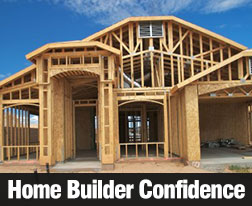 Last week’s economic news included an encouraging report from the National Association of Home Builders, whose housing market index held steady with a reading of 60 in July. This was the 13th consecutive month for readings over 50, which indicate that more builders are confident about housing markets than those who are not. July’s reading was noteworthy as it was the highest since November 2005 prior to the recession.
Last week’s economic news included an encouraging report from the National Association of Home Builders, whose housing market index held steady with a reading of 60 in July. This was the 13th consecutive month for readings over 50, which indicate that more builders are confident about housing markets than those who are not. July’s reading was noteworthy as it was the highest since November 2005 prior to the recession.
Housing Starts, Building Permits Increase
The Commerce Department provided further evidence of stronger housing markets with reports on housing starts and building permits issued in June. Housing starts rose from May’s reading of 1.07 million to 1.17 million, which surpassed the expected reading of 1.11 million housing starts.
May’s reading for housing starts was revised from 1.04 million to 1.07 million an annual basis.
Construction of apartments and other multifamily housing complexes attained their highest level since 1987, which supports reported trends that millennials who prefer to live in larger cities are renting rather than buying homes. Housing starts gained nearly 10 percent between May and June. Would-be home buyers are also renting due to tighter mortgage approval standards; others may be “sitting on the fence” as they wait for further indications of stronger labor markets and improvements in overall economic conditions.
Building permits issued in June supported trends in housing starts, with permits for multi-family housing units higher by 16. 10 percent and was the highest reading for multi-family building permits since 1990. Analysts said that the increase in multifamily building permits was in caused by the pending expiration of a tax credit for builders in New York State that was set to expire June 30.
Permits for single family homes rose only 0.90 percent in June, to an annual pace of 689,000 but this was still the highest reading for single family housing permits since 2008.
Mortgage Rates Rise, Jobless Claims Fall
Freddie Mac reported that average mortgage rates rose last week. The rate for a 30-year fixed rate mortgage averaged 4.09 percent and was higher by five basis points. The average rate for a 15-year mortgage was also five basis points higher at 3.25 percent. The average rate for a 5/1 adjustable rate mortgage was up by three basis points to 2.96 percent. Discount points were 0.60 percent for 15 and 30 year mortgages and 0.50 percent for 6/1 adjustable rate mortgages.
New jobless claims fell to 281,000 last week against the prior week’s reading of 296,000 new claims and an expected reading of 285,000 new jobless claims. Analysts said that the current reading indicates that last week’s spike in new unemployment claims was a false alarm. Seasonal anomalies and re-tooling at some auto plants were cited as causes for the prior week’s high reading. New jobless claims have remained under the benchmark reading of 300,000 since February for the longest consecutive period in 15 years.
Last week’s reports ended with the University of Michigan’s Consumer Sentiment Index, which fell from June’s reading of 96.1 to 93.3; analysts expected a reading of 95.0.
What’s Ahead
Scheduled economic reports for next week include new and existing home sales, and FHFA home prices along with weekly reports on mortgage rates and new jobless claims.
 Home builder confidence remained steady at the highest reading in almost ten years according to the National Association of Home Builders (NAHB) Wells Fargo Housing Market Index for July. The latest reading of 60 for the index was identical to expectations and June’s reading, which was revised to 60 from an initial reading of 59. The NAHB Wells Fargo Housing Market Index is based on readings of zero to 100 with readings over 50 indicating that a majority of home builders surveyed are confident about housing market conditions. July’s reading was the 13th consecutive month of readings above 50.
Home builder confidence remained steady at the highest reading in almost ten years according to the National Association of Home Builders (NAHB) Wells Fargo Housing Market Index for July. The latest reading of 60 for the index was identical to expectations and June’s reading, which was revised to 60 from an initial reading of 59. The NAHB Wells Fargo Housing Market Index is based on readings of zero to 100 with readings over 50 indicating that a majority of home builders surveyed are confident about housing market conditions. July’s reading was the 13th consecutive month of readings above 50.  Homeowners who are thinking about listing their home for sale in the coming weeks or months may be focused on improving their home to help it sell more quickly, but there also may be a focus on adding value to the home in the process. While each home is unique, there are a few projects that most homeowners would benefit from. In fact, these are a few simple and easy projects that can typicaly be completed over the course of a weekend; that can add value and desirability to the home.
Homeowners who are thinking about listing their home for sale in the coming weeks or months may be focused on improving their home to help it sell more quickly, but there also may be a focus on adding value to the home in the process. While each home is unique, there are a few projects that most homeowners would benefit from. In fact, these are a few simple and easy projects that can typicaly be completed over the course of a weekend; that can add value and desirability to the home. It is common for those who are interested in buying real estate in the near future to tune into news stories about the real estate market, and many may have heard that there is speculation about a real estate bubble that may pop soon. While this gloomy outlook on the real estate market can strike fear in some hearts and may deter a purchase until a later date, the fact is that summer 2015 is an excellent time to purchase property. In fact, there are three good reasons why potential buyers may want to start moving forward with their buying plans soon.
It is common for those who are interested in buying real estate in the near future to tune into news stories about the real estate market, and many may have heard that there is speculation about a real estate bubble that may pop soon. While this gloomy outlook on the real estate market can strike fear in some hearts and may deter a purchase until a later date, the fact is that summer 2015 is an excellent time to purchase property. In fact, there are three good reasons why potential buyers may want to start moving forward with their buying plans soon. Many home buyers who are applying for their first mortgage will go to great lengths to research the options, learn more about loan terms and generally educate themselves about a process that they are unfamiliar with. Despite these common steps that rookie mortgage applicants make, they often make similar mistakes when applying for their first mortgage. By learning about these common mistakes, you can take steps to prevent making them yourself.
Many home buyers who are applying for their first mortgage will go to great lengths to research the options, learn more about loan terms and generally educate themselves about a process that they are unfamiliar with. Despite these common steps that rookie mortgage applicants make, they often make similar mistakes when applying for their first mortgage. By learning about these common mistakes, you can take steps to prevent making them yourself. Last week’s scheduled economic events were few due to the Independence Day holiday. Freddie Mac’s weekly survey of mortgage rates brought good news as mortgage rates fell across the board. The Federal Reserve released the minutes of its most recent Federal Open Market Committee (FOMC) meeting and weekly jobless claims rose.
Last week’s scheduled economic events were few due to the Independence Day holiday. Freddie Mac’s weekly survey of mortgage rates brought good news as mortgage rates fell across the board. The Federal Reserve released the minutes of its most recent Federal Open Market Committee (FOMC) meeting and weekly jobless claims rose. Curb appeal is important in the home sales process, and this is because it will impact the overall first impression that potential home buyers have about the property. Some homeowners can easily spend a small fortune and a considerable amount of time improving curb appeal, but others may be looking for faster and easier results. The good news is that boosting curb appeal is easy and affordable to do when these three tips are followed.s
Curb appeal is important in the home sales process, and this is because it will impact the overall first impression that potential home buyers have about the property. Some homeowners can easily spend a small fortune and a considerable amount of time improving curb appeal, but others may be looking for faster and easier results. The good news is that boosting curb appeal is easy and affordable to do when these three tips are followed.s A home mortgage payment can be a large or even the largest expense in a person’s budget, and not having this payment any longer can be a life changing experience. Because of this, you may be dreaming about the day when you no longer have to make this payment.Some people may even actively make extra payments to their mortgage in order to pay the outstanding balance off more quickly.These may be funds from an IRS tax refund, cash received from the holidays or a birthday or some other windfall.
A home mortgage payment can be a large or even the largest expense in a person’s budget, and not having this payment any longer can be a life changing experience. Because of this, you may be dreaming about the day when you no longer have to make this payment.Some people may even actively make extra payments to their mortgage in order to pay the outstanding balance off more quickly.These may be funds from an IRS tax refund, cash received from the holidays or a birthday or some other windfall. While there may be instances when a homeowner must sell a property and move regardless of market conditions, there are other times when the value of the property will be a deciding factor in whether a homeowner moves or remains in the home for a longer period of time.
While there may be instances when a homeowner must sell a property and move regardless of market conditions, there are other times when the value of the property will be a deciding factor in whether a homeowner moves or remains in the home for a longer period of time. From the sales price to the general layout of the building, there are numerous factors that buyers will consider when touring homes. While there are specific factors that buyers may be searching for in a new house, there are also a few warning signs that home buyers should keep their eyes open for. The following are among the top red flags that may serve as warning signs.
From the sales price to the general layout of the building, there are numerous factors that buyers will consider when touring homes. While there are specific factors that buyers may be searching for in a new house, there are also a few warning signs that home buyers should keep their eyes open for. The following are among the top red flags that may serve as warning signs.